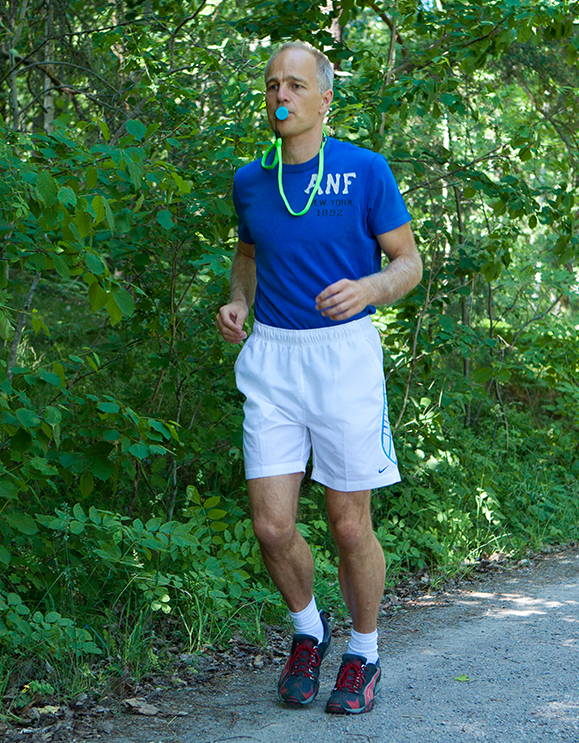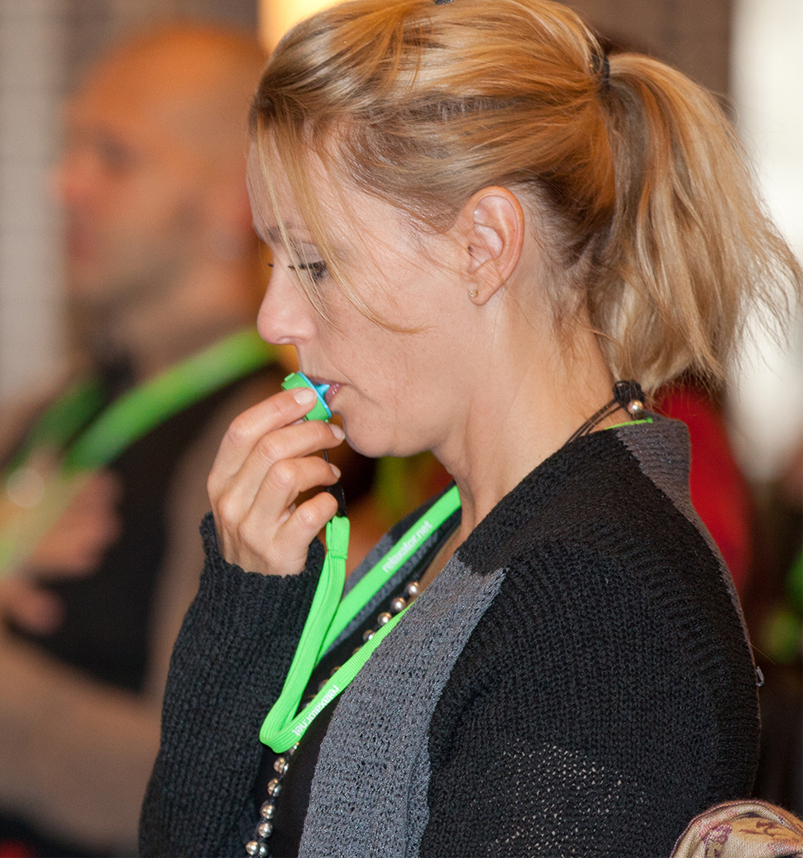
CO2 Tolerance Test Walking
PREPARATION
► Set the Relaxator on level 5 (highest resistance) and put it in your mouth.
► Take a few calm nasal breaths.
INHALE
► Take 6 steps while inhaling through your nose.
► Fill up your lungs as much as you can.
EXHALE
► Continue to count the steps, while exhaling through the Relaxator.
► Take as many steps as you can.
► You are not allowed to inhale or swallow.
CHECK THE NUMBER OF STEPS
► When you can’t exhale any longer, note the total number of steps you took.
► The inhale (6 steps) plus the exhale is your CO2 Tolerance Test Score, i.e. your CTT Score.
► Keep the Relaxator in your mouth after the CO2 Tolerance Test, and breathe in and out through your nose for a few breaths.

CO2 Tolerance Test Sitting
PREPARATION
► Set the Relaxator on level 5 (highest resistance) and put it in your mouth.
► Take a few calm nasal breaths.
INHALE
► Start a timer and fill your lungs to the max.
► Inhale for a total of around six seconds.
EXHALE
► Close your eyes, pinch your nose, and exhale slowly
► Exhale as long as possible through the Relaxator
► You are not allowed to inhale or swallow
CHECK TIME
► When you can’t exhale any longer - check the time.
► The inhale (6 steps) plus the exhale is your CO2 Tolerance Test Score, i.e. your CTT Score.
► Keep Keep the Relaxator in your mouth after the CO2 Tolerance Test, and breathe in and out through your nose for a few breaths.
Change your breathing habits now
-
Any quest for enhanced health and wellbeing should include changing your breathing habits as a basic component since breathing is an integral part of us and is with us wherever we go. While optimum breathing in our daily lives doesn’t always come naturally, it can be learned. By changing your breathing habits to a more relaxed way of moving the air in and out of your lungs, there is a great chance that you will also improve your energy levels, sleep quality, and overall health.
To assist you in improving your DAILY breathing habits, our 28-Day Conscious Breath Taining Program (in pdf-format) is of great help. The aim of the program is to support you in using the five tools of Conscious Breathing:
- Become aware of your daily breathing habits. Awareness is usually the first step towards change. The first step of this seven-step program is, therefore, to check your breathing by answering the 20 questions in the Health and Breathing Index.
- Tape your mouth shut at night. Many of us sleep with an open mouth, which automatically means that your breathing will exceed your body’s needs, i.e., we create an imbalance between oxygen (too much) and carbon dioxide (too little). Taping your mouth at night with Sleep Tape is a remarkably simple and inexpensive way to ensure that your mouth stays closed and respiration occurs only through your nose. Nasal breathing promotes a relaxed sleep and minimum energy leakage, which increases the chances that your body can heal, repair, and regenerate.
- Train with the Relaxator. With The Relaxator Breath Trainer, you can train your breathing habits so that they are more in line with your body's needs. The Relaxator helps you achieve a slow, low, and more rhythmical breath. It also increases the muscle tonus in the upper airways and strengthens the diaphragm, our most important breathing muscle.
- Physical activity with a closed mouth. Optimum breathing starts in the nose. If your nose is narrow and you find it hard to breathe through it, it is often a sign that your breathing habits has room for improvement. In the nose, under the nasal turbinates, there is erectile tissue. They swell when the CO2-pressure in our body is too low, as a defense mechanism to maintain an optimal carbon dioxide pressure. Carbon dioxide is produced in the body, and virtually all carbon dioxide leaves the body through exhalation. Physical activity with a closed mouth increases your ability to breathe through your nose. As your breathing improves and you regain an optimum carbon dioxide pressure, the erectile tissue will decrease in size and the inside of the nose will feel less crowded. Read more on how to unblock a stuffy nose.
- inXhale exercises. These are a) yoga-like exercises to open up your airways, b) relaxing exercises, and c) exercises for your daily life when the “demons”, i.e. stress, fear, worry, frustration, insecurity, etc., are about to take over 😊The exercises are easy to use, and at the same time very powerful. Check them out here out here.
-
